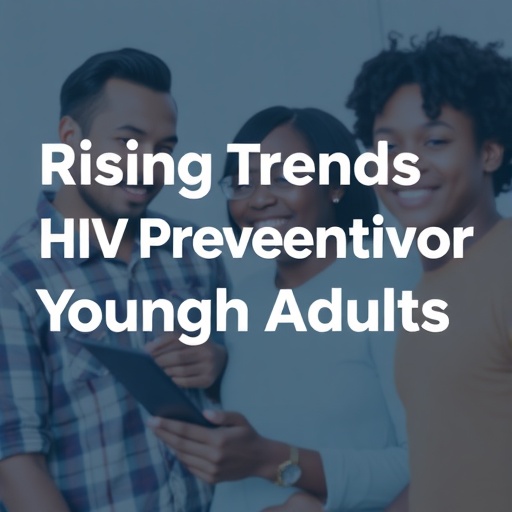The Evolving Landscape of HIV Pre-Exposure Prophylaxis: Insights from Recent Trends
In recent years, the landscape of HIV pre-exposure prophylaxis (PrEP) has undergone considerable changes. As conversations surrounding its accessibility and adoption among young adults intensify, the study by Hill et al. presents crucial data on national trends in PrEP dispensing from 2016 to 2023. This longitudinal analysis highlights the shifting dynamics and offers a retrospective look into the factors contributing to either the increase or stagnation of PrEP uptake during this pivotal period. The significance of understanding these trends cannot be overstated, as they provide a roadmap for healthcare providers, policymakers, and advocates driving change in HIV prevention strategies.
This dialogue kicked off with the emergence of PrEP as a groundbreaking option in HIV prevention, offering a proactive measure for at-risk populations to significantly lower the chances of contracting the virus. Scientists and public health officials have lauded PrEP’s efficacy, yet challenges remain in ensuring widespread access and acceptance. Hill and colleagues pinpoint critical years in the evolution of PrEP usage, illustrating how shifts in societal attitudes, healthcare policies, and public health campaigns have played a monumental role in shaping its trajectory among young adults — a demographic often at higher risk for HIV infection.
Particularly notable is the observation that while PrEP has received endorsement from various health organizations worldwide, discrepancies still exist concerning its dispensing rates among different age groups. Young adults, in particular, exhibit a pattern indicative of varied engagement with PrEP services, influencing the overall public health response to HIV prevention. The study’s findings reveal essential correlations between socioeconomic factors and PrEP access, drawing attention to the need for targeted interventions that address the barriers faced by this vulnerable population.
Moreover, the data highlight essential shifts in public perception of HIV and the resources allocated to combating it. Over time, the growing awareness and education about HIV prevention methods have fostered increased acceptance of PrEP. However, the research emphasizes that barriers such as stigma, lack of healthcare access, and misinformation remain persistent challenges. The authors assert that addressing these issues is vital for maximizing PrEP’s impact on young adults who are at increased risk of HIV infection.
Another crucial aspect of the study addresses disparities in PrEP dispensing among different racial and ethnic groups. Hill et al. shed light on inequities that persist within the healthcare system, noting how these disparities can influence national public health outcomes. By analyzing the data, the researchers provide a comprehensive view of how systemic factors converge to create barriers for certain populations, urging stakeholders to galvanize efforts towards more equitable healthcare practices.
The study highlights the importance of integrating community-focused solutions and resources geared towards improving PrEP access. Innovative approaches such as mobile health clinics and telehealth services have made strides in reaching young adults who may be reluctant to seek traditional healthcare services. These initiatives facilitate not only education but also the dispensing of PrEP, demonstrating successful models that can be replicated in other regions facing similar challenges.
Furthermore, the role of healthcare providers in promoting PrEP cannot be understated. The authors underscore that sustained education and training for medical professionals is imperative in ensuring they hold informed discussions with patients about PrEP’s benefits and potential side effects. Their research indicates that practitioners play a pivotal role in combating misinformation and stigma surrounding the medication, particularly for young adults who may otherwise feel marginalized in healthcare settings.
As the landscape of public health continues to evolve, real-time data collection remains essential to monitor trends in PrEP dispensing. Hill et al. advocate for ongoing research into the barriers faced by populations in accessing PrEP. Regular tracking of PrEP refills, adherence levels, and attitudes can shed light on the effectiveness of interventions designed to increase uptake. Such data-driven approaches empower researchers, public health experts, and advocates by providing them with the insights needed to formulate effective strategies moving forward.
The study yields a stark reminder: while achievements in HIV prevention via PrEP have been monumental, a concerted effort is needed to ensure these successes translate into improved healthcare access and outcomes for young adults, particularly those of diverse backgrounds. Stakeholders must embrace collaboration across various sectors, including government agencies, healthcare systems, and community-based organizations, to forge pathways towards greater health equity.
As we reflect on national trends in HIV PrEP dispensing, the work of Hill and colleagues acts as a clarion call to action, imploring both healthcare providers and policymakers to prioritize PrEP as a comprehensive tool in the fight against HIV. Education, advocacy, and a commitment to equity will be crucial drivers in reshaping the future landscape of HIV prevention, ultimately ensuring that no young adult is left behind in the pursuit of health, well-being, and longevity.
The time for action is now, and as we aim to tackle the barriers to accessing PrEP, it becomes essential to harness the collective will of the community to create sustainable change. By focusing our efforts on understanding and addressing the nuances of HIV prevention, we are better positioned to enhance the quality of life, reduce infection rates, and ultimately move closer to ending the HIV epidemic.
With further research and commitment, the dialogue surrounding PrEP can evolve past mere data points to become an integral part of the healthcare narrative. Hill, He, and Chua’s contributions to this dialogue mark a significant step in broadening our understanding and propulsion of HIV preventative strategies, setting the groundwork for future innovation and success.
Subject of Research: Trends in HIV Pre-Exposure Prophylaxis Dispensing among Young Adults
Article Title: Response to Letter to the Editor on “National Trends in HIV Pre-Exposure Prophylaxis Dispensing to Young Adults, 2016–2023”
Article References:
Hill, N.E., He, S. & Chua, KP. Response to Letter to the Editor on “National Trends in HIV Pre-Exposure Prophylaxis Dispensing to Young Adults, 2016–2023”.
J GEN INTERN MED (2025). https://doi.org/10.1007/s11606-025-09976-8
Image Credits: AI Generated
DOI: https://doi.org/10.1007/s11606-025-09976-8
Keywords: HIV, Pre-Exposure Prophylaxis, Young Adults, Healthcare Access, Public Health, Equity, Prevention Strategies, Stigma, Disparities, Community Solutions, Education, Research, Telehealth, Collaboration.
Tags: accessibility of PrEP for young adultschallenges in HIV prevention among youtheffectiveness of HIV pre-exposure prophylaxisevolving landscape of HIV prevention methodsfactors influencing PrEP uptakehealthcare policies impacting PrEPHIV prevention strategies for young adultslongitudinal analysis of PrEP dispensingpublic health campaigns for PrEP awarenessrole of policymakers in HIV preventionsocietal attitudes towards HIV preventiontrends in HIV pre-exposure prophylaxis





